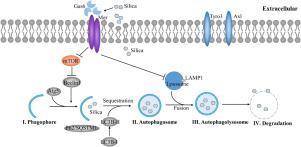当前位置:
X-MOL 学术
›
Toxicol. Lett.
›
论文详情
Our official English website, www.x-mol.net, welcomes your feedback! (Note: you will need to create a separate account there.)
Gas6 or Mer deficiency ameliorates silica-induced autophagosomes accumulation in mice lung
Toxicology Letters ( IF 3.5 ) Pub Date : 2021-02-01 , DOI: 10.1016/j.toxlet.2020.11.013 Wei Li , Li Xie , Jixuan Ma , Man Cheng , Lieyang Fan , Yiju Xu , Bin Wang , Weihong Chen
Toxicology Letters ( IF 3.5 ) Pub Date : 2021-02-01 , DOI: 10.1016/j.toxlet.2020.11.013 Wei Li , Li Xie , Jixuan Ma , Man Cheng , Lieyang Fan , Yiju Xu , Bin Wang , Weihong Chen

|
Published evidences have shown that autophagy plays an important role in silica-induced lung inflammation and collagen deposition. Our previous study found that the level of growth arrest-specific protein 6 (Gas6) in bronchoalveolar lavage fluid was increased after silica exposure. However, it is unclear whether Gas6 is involved in the regulation of silica-induced autophagy dysfunction. In this study, we observed an autophagosomes accumulation in wild-type C57BL/6 (WT) mice lung after silica intratracheal instillation and then investigated whether genetic loss of Gas6 (Gas6-/-) could ameliorate it. Our data showed that Gas6-/- mice exhibited a limited autophagosomes accumulation from days 7 to 84 after silica exposure, revealed by reduced induction and increased degradation of autophagosomes in mice lung tissue. Interestingly, silica particles could elevate the expression of Mer receptor, which was significantly decreased in Gas6-/- mice (P < 0.05). Furthermore, we found that Mer deficiency (Mer-/-) could also reduce the formation of autophagosomes and restore the function of impaired lysosomes in silica-treated mice. Taken together, our results indicate that genetic loss of Gas6 attenuates silica-induced autophagosomes accumulation partly through down-regulating the expression of Mer receptor. Targeting Gas6/Mer-mediated autophagy pathway may provide a novel insight into the prevention and therapy of silica-induced pulmonary fibrosis.
中文翻译:

Gas6 或 Mer 缺乏可改善二氧化硅诱导的小鼠肺自噬体积累
已发表的证据表明,自噬在二氧化硅诱导的肺部炎症和胶原沉积中起着重要作用。我们之前的研究发现,接触二氧化硅后支气管肺泡灌洗液中生长停滞特异性蛋白 6 (Gas6) 的水平增加。然而,目前尚不清楚 Gas6 是否参与调节二氧化硅诱导的自噬功能障碍。在这项研究中,我们观察到二氧化硅气管内滴注后野生型 C57BL/6 (WT) 小鼠肺中自噬体的积累,然后研究了 Gas6 (Gas6-/-) 的遗传损失是否可以改善它。我们的数据显示,Gas6-/- 小鼠在二氧化硅暴露后第 7 天至第 84 天表现出有限的自噬体积累,这表明小鼠肺组织中自噬体的诱导减少和降解增加。有趣的是,二氧化硅颗粒可以提高Mer受体的表达,在Gas6-/-小鼠中显着降低(P < 0.05)。此外,我们发现 Mer 缺乏 (Mer-/-) 也可以减少自噬体的形成并恢复二氧化硅处理小鼠中受损溶酶体的功能。总之,我们的结果表明,Gas6 的遗传缺失部分通过下调 Mer 受体的表达来减弱二氧化硅诱导的自噬体积累。靶向 Gas6/Mer 介导的自噬途径可能为二氧化硅诱导的肺纤维化的预防和治疗提供新的见解。我们发现 Mer 缺乏 (Mer-/-) 也可以减少自噬体的形成并恢复二氧化硅处理小鼠中受损溶酶体的功能。总之,我们的结果表明,Gas6 的遗传缺失部分通过下调 Mer 受体的表达来减弱二氧化硅诱导的自噬体积累。靶向 Gas6/Mer 介导的自噬途径可能为二氧化硅诱导的肺纤维化的预防和治疗提供新的见解。我们发现 Mer 缺乏 (Mer-/-) 也可以减少自噬体的形成并恢复二氧化硅处理小鼠中受损溶酶体的功能。总之,我们的结果表明,Gas6 的遗传缺失部分通过下调 Mer 受体的表达来减弱二氧化硅诱导的自噬体积累。靶向 Gas6/Mer 介导的自噬途径可能为二氧化硅诱导的肺纤维化的预防和治疗提供新的见解。
更新日期:2021-02-01
中文翻译:

Gas6 或 Mer 缺乏可改善二氧化硅诱导的小鼠肺自噬体积累
已发表的证据表明,自噬在二氧化硅诱导的肺部炎症和胶原沉积中起着重要作用。我们之前的研究发现,接触二氧化硅后支气管肺泡灌洗液中生长停滞特异性蛋白 6 (Gas6) 的水平增加。然而,目前尚不清楚 Gas6 是否参与调节二氧化硅诱导的自噬功能障碍。在这项研究中,我们观察到二氧化硅气管内滴注后野生型 C57BL/6 (WT) 小鼠肺中自噬体的积累,然后研究了 Gas6 (Gas6-/-) 的遗传损失是否可以改善它。我们的数据显示,Gas6-/- 小鼠在二氧化硅暴露后第 7 天至第 84 天表现出有限的自噬体积累,这表明小鼠肺组织中自噬体的诱导减少和降解增加。有趣的是,二氧化硅颗粒可以提高Mer受体的表达,在Gas6-/-小鼠中显着降低(P < 0.05)。此外,我们发现 Mer 缺乏 (Mer-/-) 也可以减少自噬体的形成并恢复二氧化硅处理小鼠中受损溶酶体的功能。总之,我们的结果表明,Gas6 的遗传缺失部分通过下调 Mer 受体的表达来减弱二氧化硅诱导的自噬体积累。靶向 Gas6/Mer 介导的自噬途径可能为二氧化硅诱导的肺纤维化的预防和治疗提供新的见解。我们发现 Mer 缺乏 (Mer-/-) 也可以减少自噬体的形成并恢复二氧化硅处理小鼠中受损溶酶体的功能。总之,我们的结果表明,Gas6 的遗传缺失部分通过下调 Mer 受体的表达来减弱二氧化硅诱导的自噬体积累。靶向 Gas6/Mer 介导的自噬途径可能为二氧化硅诱导的肺纤维化的预防和治疗提供新的见解。我们发现 Mer 缺乏 (Mer-/-) 也可以减少自噬体的形成并恢复二氧化硅处理小鼠中受损溶酶体的功能。总之,我们的结果表明,Gas6 的遗传缺失部分通过下调 Mer 受体的表达来减弱二氧化硅诱导的自噬体积累。靶向 Gas6/Mer 介导的自噬途径可能为二氧化硅诱导的肺纤维化的预防和治疗提供新的见解。



























 京公网安备 11010802027423号
京公网安备 11010802027423号